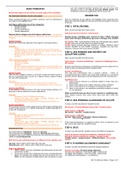out. The recipient therefore receives the sum net of tax. One
BASIC PRINCIPLES example of this is the Pay As You Earn (PAYE) system. The
employee receives the wage/salary net of income tax.
Round down figures to the nearest £ at each stage of the calculation.
The distinction between income and capital: INCOME TAX
When working through your problem question, start by collecting all Start by collecting all your figures and highlight them. Separate each
your figures and highlight them. figure into separate categories. Go back up to basic principles to see how
to do this.
Each figure will fall into one of four categories:
* Income receipts STEP 1: TOTAL INCOME:
* Capital receipts
* Income expenditure Next, we will calculate the Total Income.
* Capital expenditure
Add up all sources of income = Total Income.
Work out which category each of the figures will fall into. – any amount
will fall into one of these categories and cannot fall into more than one Exempt income: Gambling wins, Interest on ISAs / NISAs, Personal
category. injury claim damages, Redundancy pay-outs or damages max. £30,000
Income receipts: Not income: Gifts, Trivial benefits in kind max. £50 (except cash), capital
Receipt of money that originates from regular income generation. receipts from one-off sales which are capital receipts
Income: Salary, pension earnings, interest on savings, dividend, rental
Example: income, Benefits in kind (health insurance, company cars and low-
* Salary interest or interest-free loans above £10,000.)
* Trading profits of a business will be the income of the owner
* Interest charged on loans will be the income of the lender
(whether paid monthly or quarterly) STEP 2: LESS PENSION AND INTEREST ON
* Rental income paid to landlord will be the income of the QUALIFYING LOANS:
landlord.
Next, we will calculate the Net Income.
Other income that will fall in this category:
* Pension earnings Total Income – Pension contributions – Interest on Qualifying Loans =
* Interest on savings Net Income
* Dividend
* Benefits in kind provided by the company you work for (this may Pension contributions and Interest on Qualifying Loans are subject to Tax
be eg. health insurance, company cars and low-interest or Relief so they are deducted before taxing income.
interest-free loans above £10,000.)
Pension contributions:
Capital receipts: One may pay contributions into a pension scheme – either an
Falls into this category if there is an income receipt and that income is occupational pension scheme (set up by their employer) or a personal
due to a transaction that not part of a regular activity. Capital receipts pension scheme. Both types must be deducted from the Total Income.
are ‘one-off’ transactions.
Qualifying loans:
Example: 1. loans to buy an interest in, contribute capital or make a loan to a
* Selling your car if you don’t sell cars as part of a business. partnership
* Selling a painting if you don’t sell paintings as part of a business. 2. loans to buy shares in (or make a loan to) a ‘close’ company
3. loans to buy shares in an employee-controlled company
Income expenditure: 4. loans to buy shares in an employee-controlled company or invest
If the expense is incurred due to the day-to-day trading activities of a in a co-operative.
business, it will be classed as income expenditure.
Make sure that the loan you have in your scenario is a qualifying loan.
Example: Don’t deduct interest that comes from loans that don’t meet this
* Payment of rent (for business premises) criteria.
* Paying bills (eg. staff wages, heating, lighting, rent or
marketing/stationery expenses) STEP 3: LESS PERSONAL ALLOWANCE OF £12,570:
* Paying for repairs of business premises/business vehicle etc.
In step 3, we will calculate the Taxable Income.
Capital expenditure:
If you spend money on a new capital asset or enhancing an existing asset Net Income - Personal Allowance (£12,570) = Taxable Income
as part of the business, it is ‘capital’ expenditure. Capital expenditure is
a ‘one-off’ transaction. If Net income < £100,000:
Net income – £12,570 = Taxable income
Example:
* Buying new large equipment/machinery If Net income > £100,000:
* Buying new property £12,570 - (Net Income - £100,000) = Reduced allowance
* Spending money on enhancing existing equipment/machinery/ 2
premises
* Paying bills (eg. staff wages, heating, lighting, rent or If the reduced allowance is a negative number, then no allowance, and
marketing/stationery expenses) Net income will equal the Taxable income.
* Paying for repairs of business premises/business vehicle etc.
Assessment of tax: STEP 4: SPLIT:
Tax assessment for individuals – based on Tax year In step 4, we will split the Taxable income into different categories.
Tax assessment for companies – based on Financial year (although
companies may chose a different period for tax assessment purposes, Add up all income coming from dividends = Dividend Income.
called the accounting period) Add up all interest coming from savings = Savings Income.
Taxable income – Savings Income – Dividend income = Non-savings
Both the tax year and financial year are different to the calendar year. Income
Tax year: starts 6 April, ends 5 April the next year. STEP 5: IS SAVINGS ALLOWANCE AVAILABLE?
Financial year: starts 1 April, ends 31 March the next year.
In step 5, we will calculated the personal savings allowance.
How is tax collected?
1. HMRC collects tax from individuals and businesses via the self- Interest on Savings: Personal savings allowance:
assessment system. For basic rate taxpayers - their first £1,000 – taxed at 0%
2. Some cases income tax is deducted at source, meaning that the For higher rate taxpayers - their first £500 – taxed at 0%
payer of a taxable sum deducts the tax and accounts for it to For additional rate taxpayers – no allowance.
HMRC on the recipient’s behalf before the net amount is paid
BLP Tax Revision Notes | Page 1 of 5




